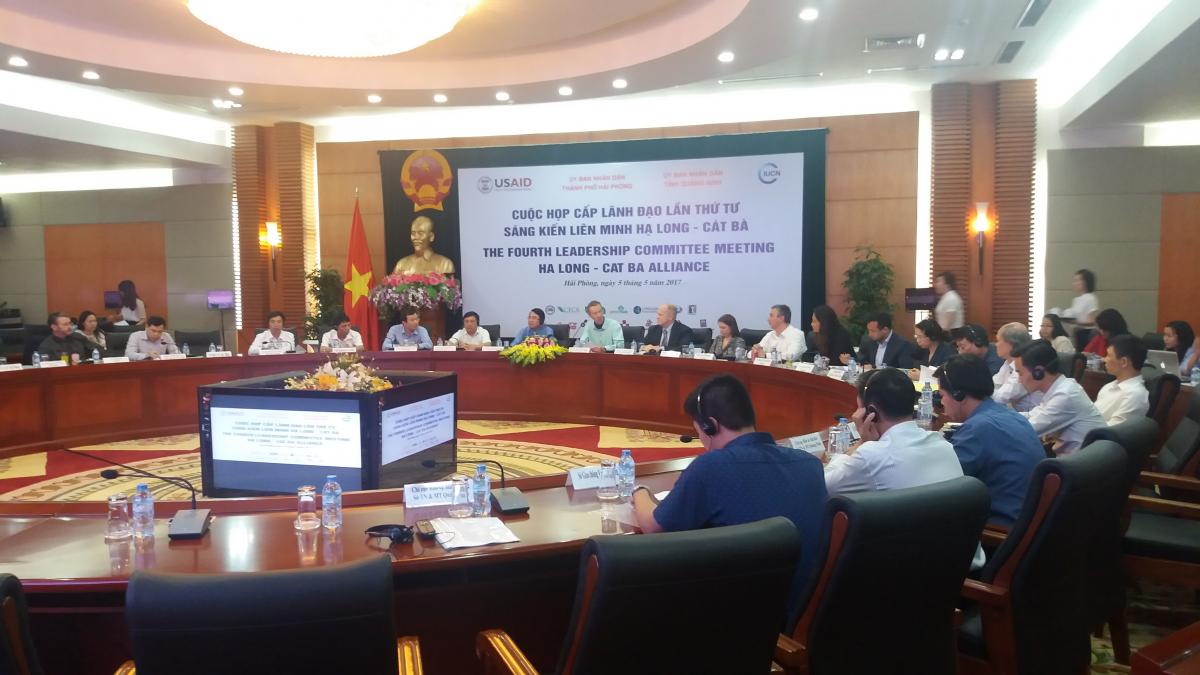“We are more effective if we work together": message from the 4th Ha Long-Cat Ba leadership committee meeting
On May 5, IUCN organized the fourth leadership committee meeting of Ha Long-Cat Ba Alliance (HLCBA). The meeting marked the end of the first phase (2014-2017) of this USAID-funded initiative and the start of the extension phase through September 2019. The meeting focused on the results of the first phase and key activities in the extension phase, particularly the renomination of Ha Long Bay (HLB) WHS to include the Cat Ba Archipelago (CBA).

Photo: Participants attended the leadership committee meeting © IUCN Viet Nam
Opening the meeting, Craig Hart, Deputy Mission Director of USAID/Vietnam, reaffirmed that the mission of the Alliance is to create a platform to connect stakeholders including local authorities, private sector, communities, media, and international and local NGOs to conserve the unique values of, and address environmental challenges in HLB-CBA. “Together, we can achieve real changes,” Craig concluded.
Through the Alliance, IUCN has continued to advocate for the WHS extension. The decision in September 2016 by Hai Phong and Quang Ninh to cooperate on the renomination was a brave one bearing in mind the amount of work involved and extra scrutiny implied, said Jake Brunner, Head of IUCN Indo-Burma Group. (In June, two international consultants recommended by IUCN visited Cat Ba to provide input to the dossier.)
In their remarks, the leaders of Hai Phong and Quang Ninh recognized the role of the Alliance in helping to solve the problems of wastewater from cruise boats and polystyrene waste from floating villages, and in raising awareness particularly among youth of the importance of environmental protection.
A recommendation that IUCN has made repeatedly is for Ha Long City to build a wastewater treatment system for the 500 daily and overnight cruise boats operating in HLB. The system would include small boats collect wastewater from these boats and transfer to a treatment station onshore. Based on a feasibility study, IUCN estimates that 500 m3 of wastewater from cruise boats is released every day into the bay. To treat this volume would need a capital cost of about $3 million and an operating cost of about $250/day. Recovering these costs within five years would require charging boats about $5/m3 of wastewater, explained IUCN’s Ms. Nguyen Thi Bich Hien. This comes to a surcharge of about $5/day for a cruise boat. In other words, it’s affordable for the boats and profitable for the investor. On this basis, IUCN called for Ha Long City to issue a tender to build and operate such a wastewater treatment system for companies to bid on. The technology exists and the economics are attractive; the only thing missing is government support.
 Photo: Many tourist boats at Tuan Chau pier are waiting for tourists to visit Ha Long Bay © IUCN Viet Nam
Photo: Many tourist boats at Tuan Chau pier are waiting for tourists to visit Ha Long Bay © IUCN Viet Nam
The issue of mass tourism attracted a lot of discussion. Representatives from the UNESCO in Hanoi, MOFA, the Vietnam Heritage Association, and several scientists argued that the ultimate goal of WHS designation is not to maximize tourism but to protect the site’s outstanding universal values. But current and planned tourism development in Cat Ba and Ha Long has raised significant public concern about the impacts to these values and to the integrity of the site. Neahga Leonard, Project Director, Cat Ba Langur Conservation Project, called for the collaboration between companies and the conservation community to ensure that tourism is developed responsibly. “We are more effective if we work together,” emphasized Neahga.
In the extension phase, the Alliance will assist the WHS renomination by reviewing biodiversity data and improve management effectiveness by supporting Ha Long Bay Management Board and Cat Ba Natural Heritage Management Board to meet the IUCN Green List standards (https://www.iucn.org/theme/protected-areas/our-work/iucn-green-list).
The Alliance will continue to engage businesses that share our vision on a range of conservation activities. By focusing on quality and added value, the Alliance will help Vietnam with the implementation of its green growth strategy, concluded Jake.



